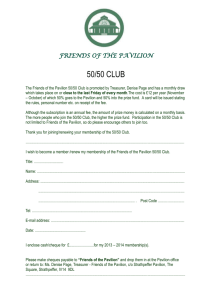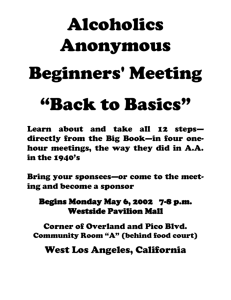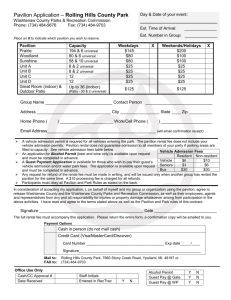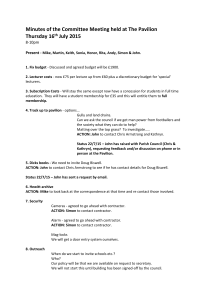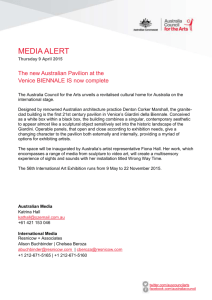Founding Chronology
advertisement
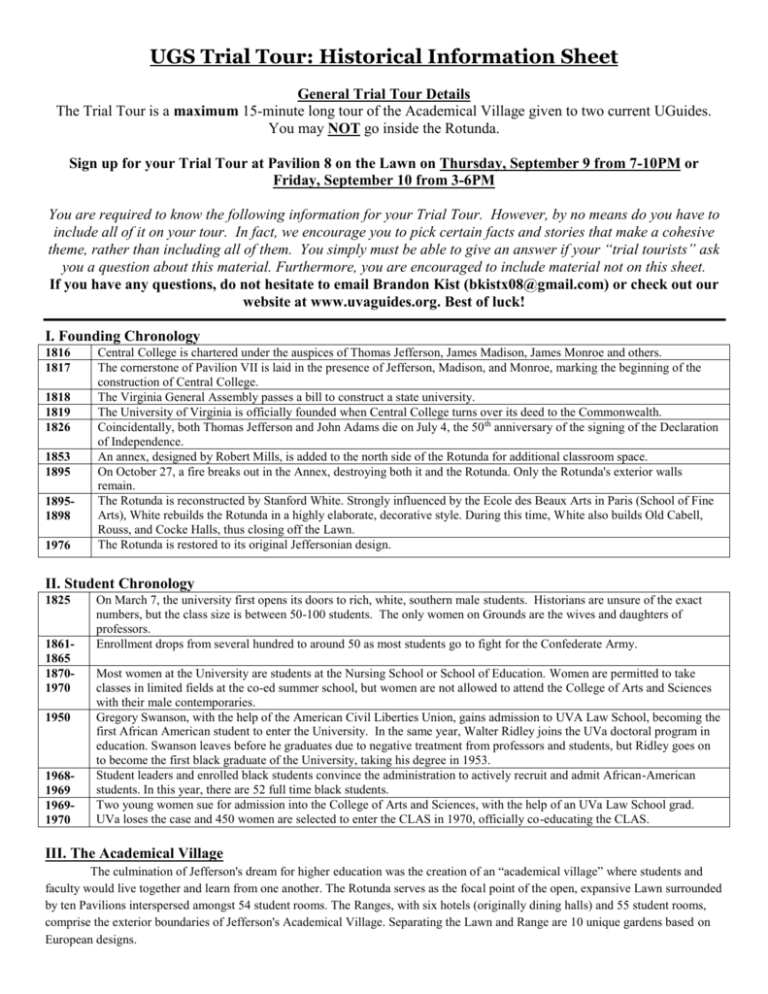
UGS Trial Tour: Historical Information Sheet General Trial Tour Details The Trial Tour is a maximum 15-minute long tour of the Academical Village given to two current UGuides. You may NOT go inside the Rotunda. Sign up for your Trial Tour at Pavilion 8 on the Lawn on Thursday, September 9 from 7-10PM or Friday, September 10 from 3-6PM You are required to know the following information for your Trial Tour. However, by no means do you have to include all of it on your tour. In fact, we encourage you to pick certain facts and stories that make a cohesive theme, rather than including all of them. You simply must be able to give an answer if your “trial tourists” ask you a question about this material. Furthermore, you are encouraged to include material not on this sheet. If you have any questions, do not hesitate to email Brandon Kist (bkistx08@gmail.com) or check out our website at www.uvaguides.org. Best of luck! I. Founding Chronology 1816 1817 1818 1819 1826 1853 1895 18951898 1976 Central College is chartered under the auspices of Thomas Jefferson, James Madison, James Monroe and others. The cornerstone of Pavilion VII is laid in the presence of Jefferson, Madison, and Monroe, marking the beginning of the construction of Central College. The Virginia General Assembly passes a bill to construct a state university. The University of Virginia is officially founded when Central College turns over its deed to the Commonwealth. Coincidentally, both Thomas Jefferson and John Adams die on July 4, the 50 th anniversary of the signing of the Declaration of Independence. An annex, designed by Robert Mills, is added to the north side of the Rotunda for additional classroom space. On October 27, a fire breaks out in the Annex, destroying both it and the Rotunda. Only the Rotunda's exterior walls remain. The Rotunda is reconstructed by Stanford White. Strongly influenced by the Ecole des Beaux Arts in Paris (School of Fine Arts), White rebuilds the Rotunda in a highly elaborate, decorative style. During this time, White also builds Old Cabell, Rouss, and Cocke Halls, thus closing off the Lawn. The Rotunda is restored to its original Jeffersonian design. II. Student Chronology 1825 18611865 18701970 1950 19681969 19691970 On March 7, the university first opens its doors to rich, white, southern male students. Historians are unsure of the exact numbers, but the class size is between 50-100 students. The only women on Grounds are the wives and daughters of professors. Enrollment drops from several hundred to around 50 as most students go to fight for the Confederate Army. Most women at the University are students at the Nursing School or School of Education. Women are permitted to take classes in limited fields at the co-ed summer school, but women are not allowed to attend the College of Arts and Sciences with their male contemporaries. Gregory Swanson, with the help of the American Civil Liberties Union, gains admission to UVA Law School, becoming the first African American student to enter the University. In the same year, Walter Ridley joins the UVa doctoral program in education. Swanson leaves before he graduates due to negative treatment from professors and students, but Ridley goes on to become the first black graduate of the University, taking his degree in 1953. Student leaders and enrolled black students convince the administration to actively recruit and admit African-American students. In this year, there are 52 full time black students. Two young women sue for admission into the College of Arts and Sciences, with the help of an UVa Law School grad. UVa loses the case and 450 women are selected to enter the CLAS in 1970, officially co-educating the CLAS. III. The Academical Village The culmination of Jefferson's dream for higher education was the creation of an “academical village” where students and faculty would live together and learn from one another. The Rotunda serves as the focal point of the open, expansive Lawn surrounded by ten Pavilions interspersed amongst 54 student rooms. The Ranges, with six hotels (originally dining halls) and 55 student rooms, comprise the exterior boundaries of Jefferson's Academical Village. Separating the Lawn and Range are 10 unique gardens based on European designs. Jefferson originally assigned an individual academic discipline to be studied in each pavilion, such as the study of ancient languages or law, and classes for that discipline were held on the ground floor of the pavilion, while the professor of that discipline and his family resided on the upper floor of the pavilion. For example, law classes originally met on the ground floor of Pavilion III, and the professor of law lived on the upper floor of Pavilion III. Today, all of the pavilions, except Pavilion VII, which is the Colonnade Club, are still used as faculty residences, although both floors are now devoted to faculty living quarters, with the exception of Pavilion VIII. Classes are still taught on the ground floor of Pavilion VIII, while a faculty member lives on the upper floor, making it the only pavilion to serve its original purpose. Finally, each Lawn Room now houses a selected fourth-year student who has contributed significantly to the University. Jefferson designed the academical village in this way because he sought to avoid the example of places like William and Mary, which, at the time, consisted of one large building where students ate, studied, slept, and did everything else. Jefferson did not believe these large buildings were conducive to health or intellectual interaction, and thus the academical village was born. IV. The Rotunda Modeled after the Pantheon in Rome, the Rotunda was the last of the original buildings to be constructed (1823-1826). Before the fire, the Rotunda housed classroom space on the first two floors and the library in the Dome Room. Creating a University centered around a library rather than a chapel was unconventional and controversial in Jefferson’s day. This decision represents Jefferson’s desire to focus his university on the acquisition of knowledge and the separation of church and state. The library was moved from the Rotunda to Alderman Library in 1938. The Rotunda still functions as a meeting place for the Board of Visitors, a study space for students, a venue for important speakers, and as the repository for selected books. Some classes are still held in the Rotunda, usually one per semester. V. The Pavilions All of the Pavilions are modeled after Greek and Roman temples, with the exception of Pavilion IX. The windows of Pavilion I are separated by the “floating balcony,” creating the illusion of one long continuous Pavilion I window, emblematic of the design of ancient classical temples. Iron rods, the first exterior use of structural iron in America, supported the balcony until 1997, when the balcony collapsed during Final Exercises, killing one. Measures have since been taken to ensure the stability of all the balconies on the Lawn. This pavilion is one of two pavilions adorned by ornate Corinthian capitals, the other being Pavilion VIII. Recently, Pavilion III this Pavilion was significant as the home of the Harmon family, the first African-American pavilion residents in UVa history. Beverly Harmon was Assistant Dean of Students at the UVa Law School, while her husband, William Harmon, was a Senior Vice President for Development for UVa. They moved out in 2005. Pavilion VII The first pavilion and the only one with an arcade. Home to the University library until the completion of the Rotunda in 1826. Pavilion VII was converted to the Colonnade Club, a faculty-alumni social club, in 1907. Remember: this is the pavilion where the founders laid the cornerstone of the University. Also note the Seven Society plaque. Pavilion VIII The only pavilion that currently demonstrates the original Jeffersonian setup of classes on the main floor and a professor living on the upper floor. Also home to the UGuide office and a student lounge. An open skylight and arched doorway allow light to enter while keeping out the rain. This pavilion is based on a Pavilion IX French garden house that Jefferson visited while serving as Minister to France from 1785 to 1789. Pavilion IX best illustrates that though the Pavilions share a certain neoclassical standard, they also have many stylistic differences. On Nov. 12, 1840, Professor John Davis was shot outside this pavilion by a masked student, marking the height of Pavilion X negative relations and distrust between students and faculty at the University. Two years later, as relations had not improved, Henry St. George Tucker, also a resident of Pavilion X, instituted the first version of the Honor System here at UVa with the consent and cooperation of the students. Important Try- Out Dates to Remember: Trial Tour Sign Ups: Thursday, September 9th 7-10pm – Pavilion 8 Friday, September 10th 3-6pm – Pavilion 8 Trail Tours: Week of Sunday, September 12th thru Friday, September 17th Dome Room Meeting and Interview Sign Ups: Saturday, September 18th 1-3pm – Rotunda Dome Room Interviews on the Lawn: Week of Sunday, September 19th thru Thursday, September 23rd

